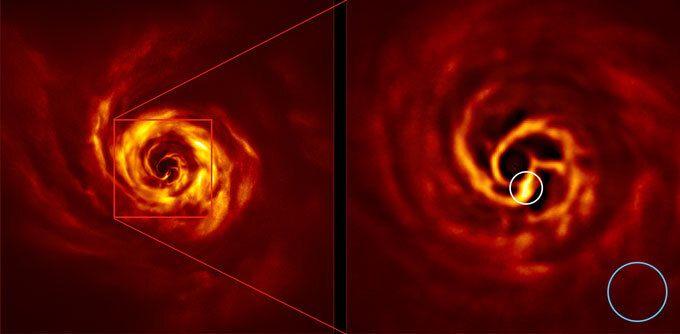For the first time, astronomers may have seen direct evidence of a planet forming around a young star.
A spiral disk of gas and dust surrounding the star AB Aurigae contains a small S-shaped twist near the spiral’s center, infrared telescope images show.
That twist “is the precise spot where a new planet must be forming,” says astrophysicist Emmanuel Di Folco of the University of Bordeaux in France.
Previously, astronomers have seen gaps (SN: 11/6/14) and large-scale spirals (SN: 6/14/18) that are thought to be created by unseen planets in disks of gas and dust around young stars. Theories of how planets coalesce and gather material from these disks predict that planets’ motions would further twist the gas around them like swirling skirts, pinpointing a planet’s location (SN: 5/11/18).
Now, Di Folco and colleagues have used infrared observations from the Atacama Large Millimeter/submillimeter Array and the Very Large Telescope, both in Chile, to find a spiral and zero in on one such S-shaped twist around AB Aurigae. The team describes its findings in the May Astronomy & Astrophysics.
 A close-up of the disk of gas and dust (seen here in infrared light) around the young star AB Aurigae (left) reveals a bright knot (right, circled in white) where astronomers think a planet is coalescing. For scale, the blue circle represents the size of Neptune’s orbit.A. Boccaletti et al/Astronomy & Astrophysics 2020, ESO
A close-up of the disk of gas and dust (seen here in infrared light) around the young star AB Aurigae (left) reveals a bright knot (right, circled in white) where astronomers think a planet is coalescing. For scale, the blue circle represents the size of Neptune’s orbit.A. Boccaletti et al/Astronomy & Astrophysics 2020, ESO
“It was amazing,” Di Folco says. “It was exactly as we were expecting from the theoretical predictions of planet formation.”
The star, about 520 light-years away in the constellation Auriga, is just 4 million years old, about one one-thousandths of the age of the sun. “It’s really a baby,” Di Folco says.
The potential planet’s exact mass is not known, but it probably would have to be a gas giant like Jupiter rather than a rocky planet like Earth to make such big waves in the disk. And it might not be alone — there’s a hint of another planet near the disk’s outer edge.
[embedded content]
Zooming in on the star AB Aurigae, located about 520 light-years away in the constellation Auriga, reveals a swirl of gas and dust that includes a small S-shaped region where a new planet may be forming.
Source: Space & Astronomy - www.sciencenews.org



